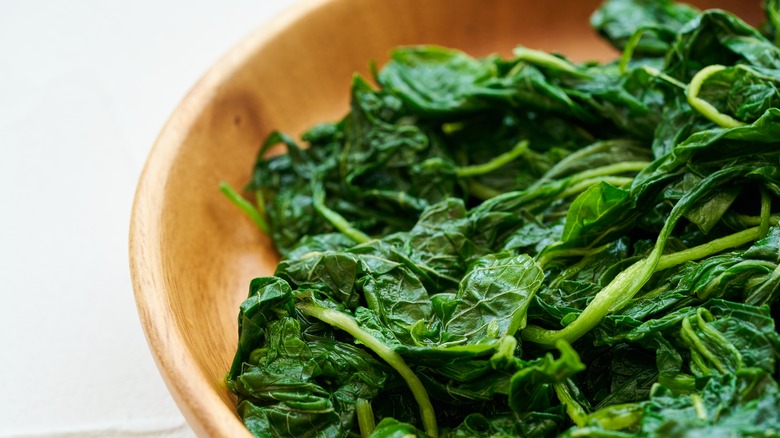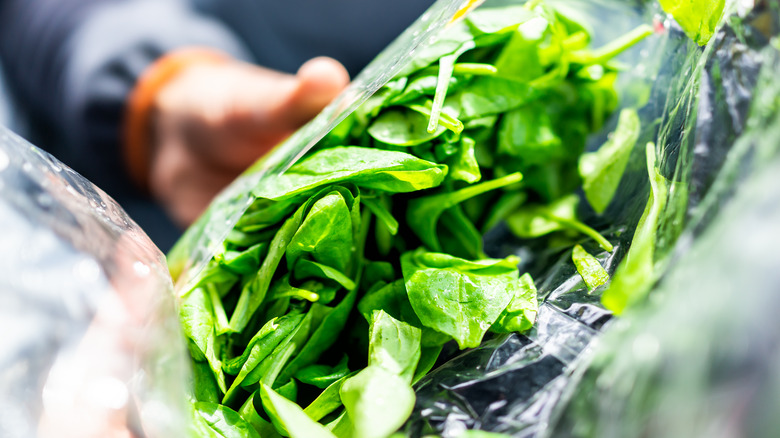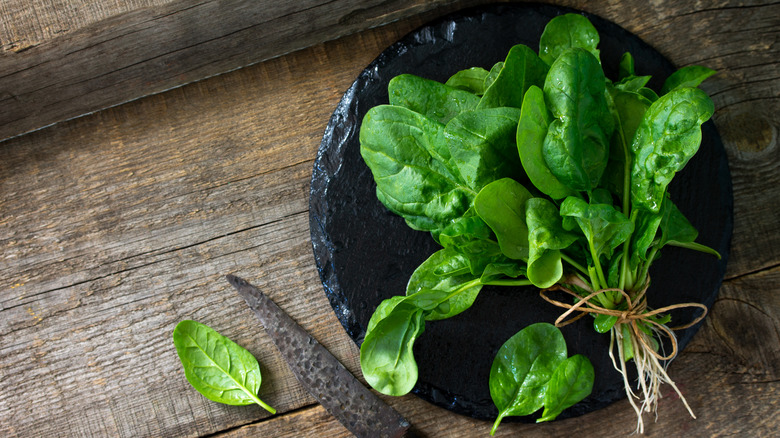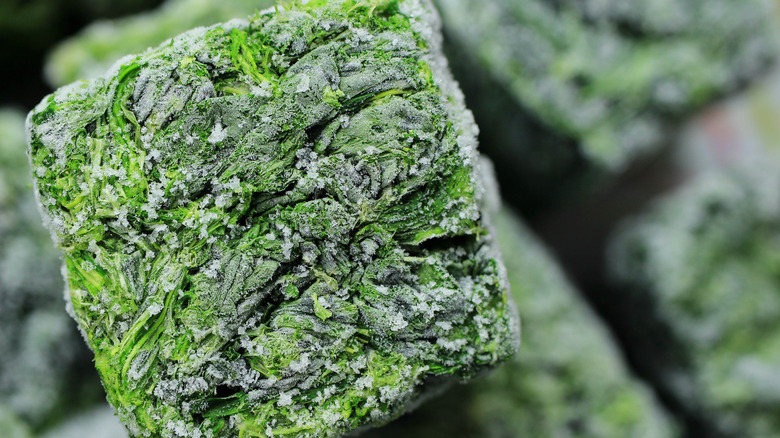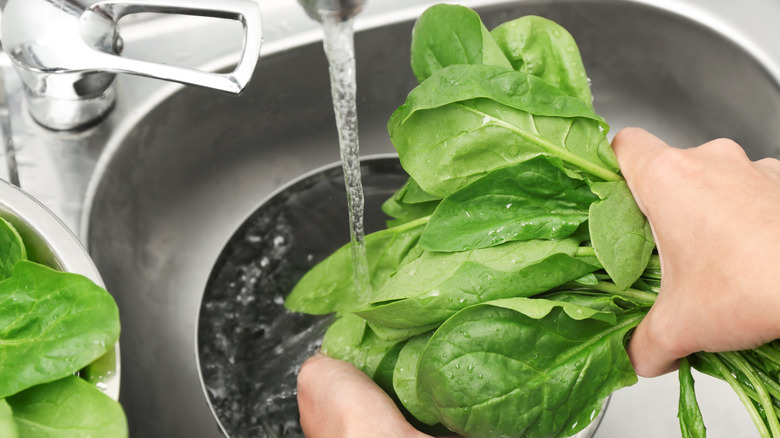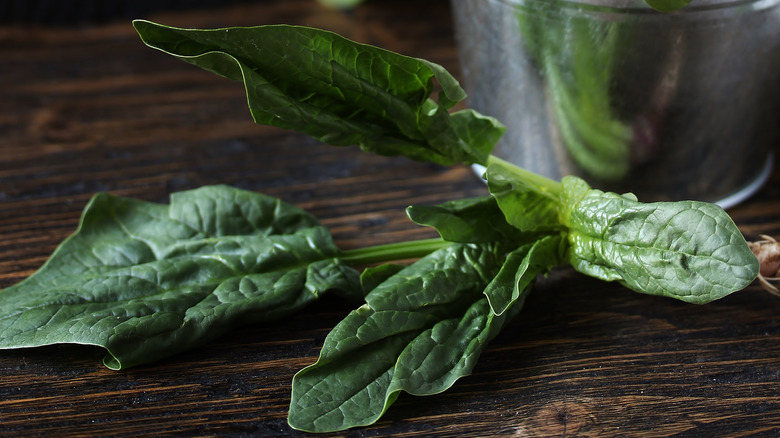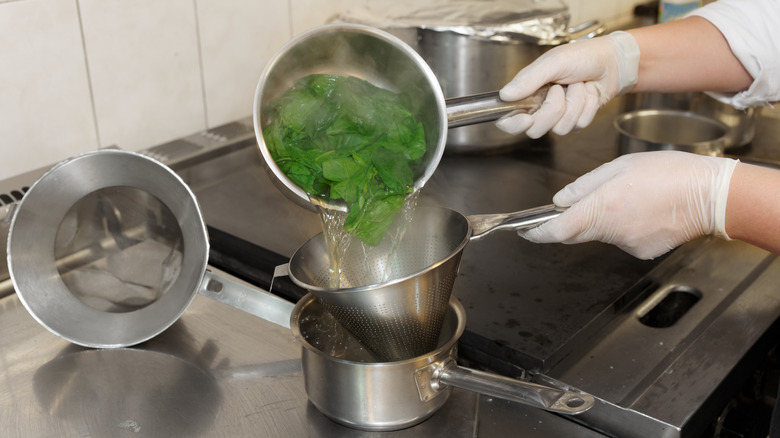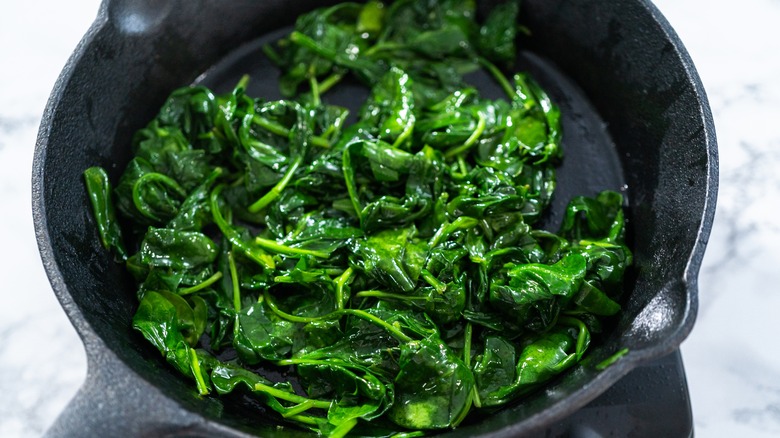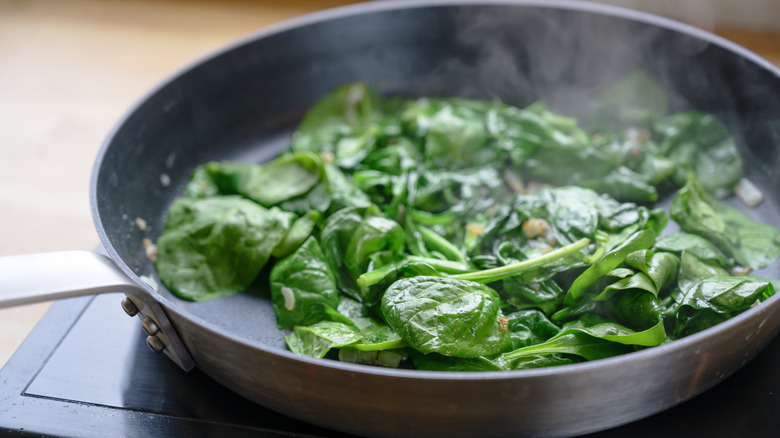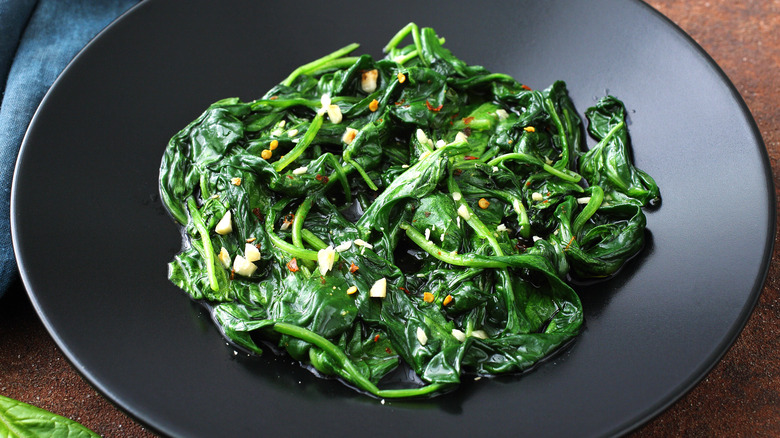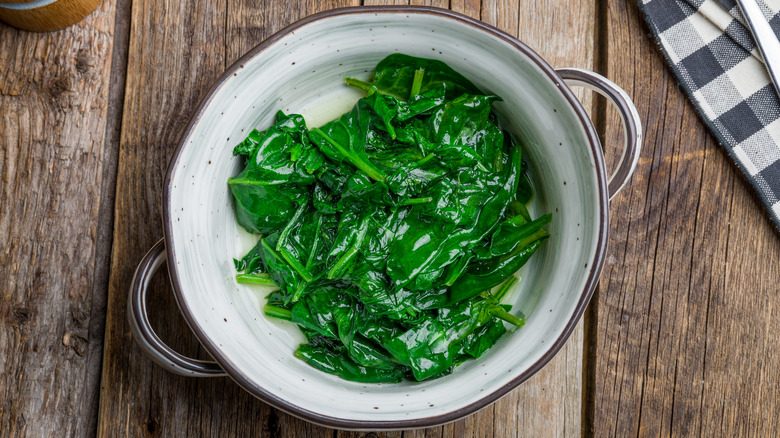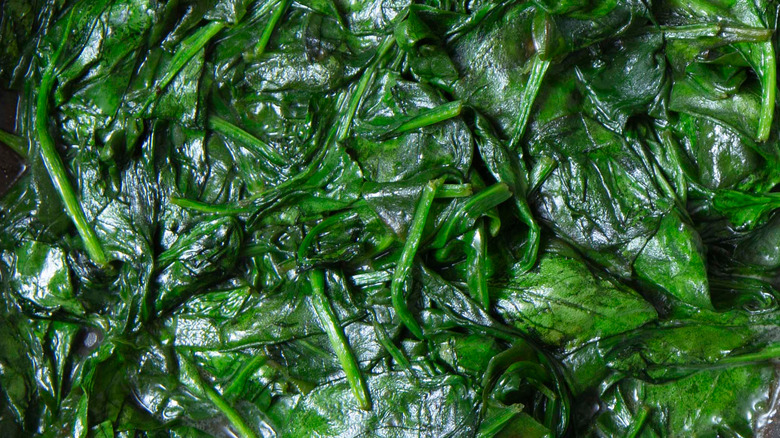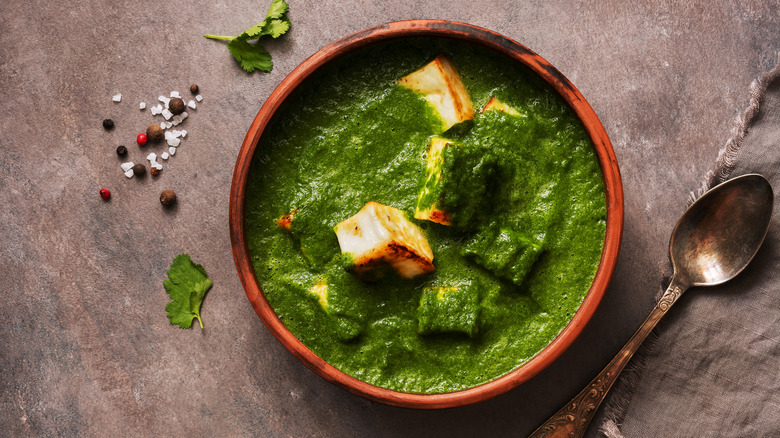12 Mistakes To Avoid When Cooking Spinach
Healthful, versatile, and flavorful, spinach is an important superfood and a great way to incorporate nutrition into your cooking. Its mild flavor and soft texture lend well to a wide variety of dishes and cuisines. And it can be prepared in a multitude of ways to suit just about anyone's taste buds. Spinach leaves are packed with fiber, which promotes healthy digestion — they're also loaded with important vitamins and minerals.
While spinach can be enjoyed raw and is certainly healthy either way, cooking spinach unlocks certain nutritional advantages. When spinach is raw, its natural levels of oxalic acid can sometimes get in the way of your body's natural ability to absorb important nutrients like iron and calcium. But when it's cooked with heat, that acid is broken down. Still, uncooked spinach has its own benefits: It's packed with nutrients that can be easier absorbed by our bodies in a raw state. Much of this varies depending on what you already have in your stomach and your overall body composition.
With all of these benefits, it makes sense to add spinach to your regular meal rotation. However, there are a few mistakes commonly made when preparing this leafy green. To get the most out of cooking this vegetable, make sure you keep these missteps in mind so that you can avoid them, and you'll be able to effortlessly cook flawless spinach dishes anytime the mood strikes.
1. Storing spinach improperly
Spinach is a delicate ingredient that has the tendency to spoil quickly — one minute, you have beautiful, bright green leaves, and the next moment a rotting brown mess. The two main things to be aware of to ensure your spinach lasts as long as possible are moisture and temperature: You want to keep it dry and cold. The leaves of spinach contain a lot of moisture which is slowly released as it sits, so the goal is to limit this liquid's contact with the leaves.
Storing spinach in layers separated by paper towels works like a charm, absorbing any water the spinach exudes. Make sure you're using a container large enough so that the spinach isn't crushed or cramped — airflow will also help keep moisture from taking over. Of course, you want to make sure the leaves are nice and dry before placing them in their storage container, too. Overall, it's best not to wash them until you're ready to cook.
Don't leave your spinach out at room temperature for too long, either — it's best to get it in the refrigerator when it's as fresh as possible. The cool temperatures will help it maintain its crispness, so it's less likely to go limp. You can also freeze spinach yourself by washing, blanching, and draining it thoroughly, then wrapping it in your desired portions and shapes and keeping it in the freezer until you need it.
2. Cooking baby spinach instead of mature spinach
Baby spinach is the same plant as regular spinach — the leaves are simply picked when it is younger. Smooth, tender, bright green baby spinach is hard to resist at the market compared to the grizzled, wrinkly leaves of a bunch of mature spinach. And if you're buying spinach to eat raw, say in a spinach salad or a green smoothie, go ahead and reach for the baby ones. Their mild flavor and crisp texture make these leafy greens ideal for raw preparations.
However, if you're looking for spinach to cook, make sure you opt for mature leaves. The mellow flavor and texture of baby spinach are lost quickly when the leaves come into contact with heat. By contrast, the stronger and more substantial structure of mature spinach holds up much better when cooked, whether it's blanched, lightly sautéed, or baked in a spinach artichoke frittata. Plus, mature spinach has a more intense flavor that can be great depending on the dish.
3. Overlooking frozen spinach
Good quality, fresh bunches of spinach straight from the farmer's market can't be beaten when it comes to quality. However, not everyone has regular access to the freshest vegetables. Since spinach can spoil quickly if it's not used right away, it's not always feasible to keep a fresh bunch on hand. That's when it's time to head to the freezer aisle.
While some may really dislike the idea of choosing frozen vegetables instead of fresh, when it comes to spinach, you're not giving much of anything up when making the swap. Frozen spinach is just as great as fresh. According to the American Institute for Cancer Research, frozen spinach offers the convenience of not having to carefully wash and store each leaf. Not to mention that with frozen, you don't have to worry about it browning and wilting in your refrigerator. Frozen spinach is ready to go even if you wait a bit longer to use it. It's also easy to incorporate into soups, stir fry recipes, smoothies, pasta bakes, you name it.
Be aware of the moisture content of frozen spinach –- after it's thawed, it should be wrung out or drained to avoid waterlogging the dish you're adding it to. You can save the liquid that drains from the spinach if you like, as it contains nutrients like vitamin C, and use it as a nutrition-boosting cooking liquid.
4. Not rinsing leaves thoroughly
Like any vegetable that comes out of the dirt, spinach needs a good, thorough wash to rid it of any grit and debris that may have hitched a ride from the farm. Pesticides and germs that can cause foodborne illnesses, like e. coli and salmonella, may also be present – so make sure you take the time to clean every leaf.
The best way to clean spinach and other leafy greens, according to the Centers for Disease Control, is by simply rinsing them under running water. Make sure your hands are properly washed so that you can dislodge any caked-on dirt without worrying about adding germs of your own. While some people recommend soaking your spinach, this method can be a bit problematic. If there are harmful bacteria on any one of the leaves, they will make their way into the water and spread to the whole bunch. Never use soap or bleach when cleaning your spinach, or any other vegetables for that matter — a simple stream of water is all you need.
5. Not sorting out bad leaves and tough stems
It's tough, and most of the time impossible, to examine each individual leaf in a bunch or bag of spinach at the market before you make a purchase. You may grab a batch that looks perfectly fresh and vibrant green, only to get home and find upon closer inspection that there are yellow or wilting leaves hiding among the healthy ones. This doesn't mean the whole bunch is bad, but it does mean you should immediately do some sorting.
Before you store your spinach, go through each leaf and remove any that are discolored, mushy, or slimy. If you leave these in with the rest of the bunch, the rot can spread quickly to the healthy leaves and ruin the whole batch. Leaves that are only slightly wilted aren't dangerous, but if you're not planning to use them right away, they may not last long, so use your discretion when deciding whether to keep them or throw them out. If in doubt, use your nose — any leaf that has a scent of decay should be tossed immediately.
As far as stems go, it's up to personal preference whether you enjoy the firm texture of stems or prefer to remove them. But if you see any stems that look brown or feel hard and woody, it's best to get rid of them.
6. Not blanching the leaves first
You may have heard that blanching is a good step to take when prepping vegetables, including spinach. But what is blanching exactly, and why should it be done? To blanch vegetables, you simply submerge them briefly — often for less than a minute — in a pot of boiling water. Then they're removed and thrown in an ice bath to stop the cooking process. This quick technique helps to preserve their color, as well as texture, and it also removes some bitter flavors. The quick zap in scalding hot water also acts as an extra cleaning step, taking care of any dirt or germs that may have been missed during the initial washing stage.
Blanching spinach also reduces the presence of a compound called oxalic acid, which can hinder the body's ability to absorb calcium. Once the spinach is blanched, cooled, and drained — make sure to get as much water out of it as possible — it can be stored for several days in the refrigerator and reheated, added to other dishes, or even eaten as-is at your leisure. Blanching is an important step to take before freezing spinach, as well. It'll maintain its vibrant green hue and fresh flavor thanks to the blanching process, even if stored in the freezer for months.
7. Not cooking enough spinach
The first time you cook spinach, you might wonder, where did it all go? A huge bowl full of raw spinach leaves somehow shrinks to a minuscule serving after it spends some time in a hot pan. That's because a significant amount of spinach is made up of water that, when heated, is released from the leaves, causing them to shrivel to a tiny percentage of their uncooked size. It's important to understand this phenomenon when planning a spinach recipe so you know how much to purchase and aren't left with a thimbleful of greens to serve a table of diners.
As a general rule of thumb, spinach cooks down to about a tenth of its raw volume. When you're cooking from a recipe, make sure you note whether it specifies raw or cooked spinach, as the amounts will be quite different — if it calls for a cup of cooked spinach, you'll need 10 cups of leaves to get there. When in doubt, it doesn't hurt to buy more than you think you need since it cooks down so significantly.
8. Overcooking your spinach
Mature, full-leaf spinach can take on a lot of different cooking processes, each of which will lend it a unique texture and character. Whether you're boiling, sautéing, or using any other method, the most important thing is to not overcook it. Overcooked spinach can take on a bitter burnt flavor and have an unpleasant mushy texture – not a good way to get people to eat their greens.
Direct heat methods like sautéing are most likely to end up with overcooked spinach and call for extra diligence. If you're cooking on the stovetop, make sure you're keeping a watchful eye on your pan. Once the moisture is released from the leaves as they're heated, they cook down very quickly. If you want them to maintain some crispness and structure, they only need a few minutes of cooking time to wilt. Once they've cooked to your liking, remove the pan from the burner, as the residual heat will continue cooking them — best to remain on the side of caution when it comes to spinach.
9. Under or overseasoning your spinach
Spinach has an earthy, vegetal flavor that's mild compared to many other greens, like chard or kale, that possess a stronger, more bitter taste. Thus spinach doesn't need too much added to it to complement its character, as you don't need to tame or mellow any overly intense or potentially unpleasant flavors. However, if you leave it too plain, you run the risk of it being bland and one-dimensional. There are a lot of ingredients you can reach for to enhance the taste of your spinach, whether you want to use a subtle hand or create a rich tapestry of flavors.
Salt is a must to brighten and boost any spinach dish, and a little black pepper adds a touch of heat and intensity. If you're going for simple flavors, that's all you need. An acidic element will elevate it even more, like lemon juice or vinegar, to provide a nice zippy contrast to the earthiness of the leaves. Garlic, shallots, or other onions make a good match with spinach, whether you leave them fresh and pungent or caramelize or roast them to bring out a deep, sweeter flavor. And if you like spice, just about any will do, from a simple dash of red chile flakes to complex blends like garam masala.
10. Not wringing out or draining moisture after cooking
Spinach releases so much water as it cooks that it can often end up sopping wet in a pool of its own moisture. Unless you're making soup, that's probably not the texture you have in mind. Adding one simple moisture-ridding step to your spinach cooking routine can eliminate this problem, and there are several methods you can employ that work equally well whether you're preparing spinach from fresh leaves or frozen.
To drain this excess liquid from your leaves, after you're done cooking your spinach, throw them into a colander over the sink. You can then press or squeeze the leaves to get the moisture to drain faster. Alternatively, if you have a salad spinner, a quick whirl can achieve the same effect. Pressing the cooked spinach in a potato ricer is another useful technique, although depending on the size of your ricer, this can work best with smaller batches. You can wring the liquid out using a kitchen towel, but be aware that the fabric will likely end up tinted green. Disposable items like paper towels or cheesecloth can be used instead to avoid an unexpected dye job.
11. Letting spinach steam after cooking
After the spinach is cooked and drained, you might think you're out of the woods, but there's one more pitfall to be wary of when moving your spinach from the cooking vessel to the serving dish. Piling spinach leaves that are still piping hot on top of one another will cause them to continue to cook, with the heat from the trapped bottom leaves creating a steaming effect that impacts the whole batch. This can tragically overcook your spinach at the last minute, leaving you with soggy, sopping leaves with a mushy, mealy texture.
To avoid this sad fate, give your cooked spinach room to breathe. Choose a serving dish that has enough width so that you can spread your spinach out in a relatively shallow layer, and the leaves will maintain their textural integrity. This is especially important if you're still finishing up other elements of your meal before your spinach is ready to be served and enjoyed.
12. Cooking spinach the same way every time
It's easy to get stuck in a cooking rut, especially with an ingredient like spinach. There's something seductively simple about a simple blanch or sauté that requires minimal time, effort, and components. But should you wish to branch out and explore everything that spinach is capable of, there are endless possibilities when it comes to cooking creatively with spinach, thanks to its versatility and mild flavor.
Spinach makes a great addition to pasta, whether tossed with freshly-cooked noodles like spaghetti or added to filling for baked dishes like cheese and spinach manicotti with meat sauce. You don't have to worry about spinach's high moisture content when you use it as an ingredient in soups, like this spring chicken and greens soup, that's both comforting and healthy. Try your hand at the classic Greek spanakopita if you're looking for a fun, in-depth kitchen project.
On the next big game day, you could put together a spread of dips that all include spinach — there's no shortage of them, from crock-pot jalapeño spinach dip to well-loved spinach artichoke dip. Spinach is an integral ingredient in many Indian dishes, including palak paneer. And no brunch is complete without at least one spinach-laden item, from quiches and frittatas to elegant eggs Florentine. Let your inspiration guide you, and you'll find that spinach can be one of the most fun and adaptable ingredients in your kitchen.
